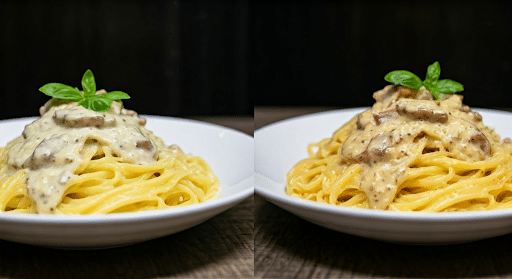There’s an undeniable appeal to Italian cuisine. Its signature sauces, diverse pasta shapes, and the savoury magic they create when combined have garnered international popularity. Two Italian sauces, Alfredo and Carbonara, have mainly won many hearts with their creamy textures and vibrant flavours. But what exactly distinguishes Alfredo from Carbonara in the ongoing debate on Carbonara vs Alfredo?
Though both sauces are creamy and often used as pasta toppings, their origin, ingredients, preparation methods, flavour profiles, and health considerations differ. This comparative blog delves deeper into these two favourite types of pasta sauces to unravel what makes them both so delightful and distinct.
So, let’s embark on this delectable journey, and while we’re at it, also find answers to some frequently asked questions about Alfredo and Carbonara.
The Origins of Alfredo and Carbonara
The Alfredo and Carbonara sauces are rooted in Italy’s rich culinary heritage, but their creation stories differ. Let’s briefly look at the history of both sauces.
Alfredo Sauce History
The origin of Alfredo sauce dates back to 1914. Alfredo di Lelio in Rome prepared this sauce for his pregnant wife, using just butter and Parmesan cheese. His ‘Fettuccine Alfredo’ became a beloved dish beyond Italy after American film stars Mary Pickford and Douglas Fairbanks shared it in the U.S. Following slight adaptations, it gained popularity on American menus. Today, the creamy Alfredo sauce remains a timeless culinary favourite worldwide. According to the founder of Pete’s Protein Pasta, Alfredo’s appeal is its ability to be both a comfort food & a sophisticated dish at the same time, making it a global culinary icon.
Carbonara Sauce History
The origins of Carbonara sauce are less precise than Alfredo’s. It first appeared in Ippolito Cavalcanti’s 1839 Neapolitan cookbook without a detailed origin backstory. The dish’s name, meaning “coal-worker’s style,” may link it to simple, hearty meals for coal workers or the black pepper flecks resembling coal. Another theory ties it to World War II, when Italians combined powdered eggs and bacon from Allied rations. Despite its mysterious origins, Carbonara has become a beloved classic, cherished by cooks worldwide.
What Are The Ingredients and Preparation Style of These Sauces?
Despite their shared creamy demeanour and white colour base, Alfredo and Carbonara significantly differ in their ingredient lists and preparation methods. Let’s delve deeper into each sauce’s specifics, from its representative ingredients to the individual steps employed in its preparation.
Alfredo Sauce Ingredients and Preparation
Alfredo sauce, known for its velvety richness and buttery charm, requires only a handful of essential ingredients:
- Butter is the base of this sauce, giving it a luxuriously rich and smooth texture.
- Heavy Cream adds another layer of creaminess, making the sauce thick and luscious.
- Parmesan Cheese is essential for providing the sauce with a nutty depth and complexity.
- Garlic often makes an appearance, adding a subtle hint of sharpness.
- Parsley, although optional, contributes a fresh counterpoint to the sauce’s inherent creaminess.
Creating Alfredo sauce is a straightforward affair. Here’s how:
- To prepare Alfredo sauce, finely minced garlic is sautéed in melted butter.
- Heavy cream is then added and simmered until thickened.
- Once removed from heat, grated Parmesan is stirred in, followed by parsley if desired.
- The sauce is poured over fettuccine and tossed to coat every strand, creating a rich, creamy Fettuccine Alfredo, which pairs beautifully with chilled white wine or red wine.
Carbonara Sauce Ingredients and Preparation
Carbonara sauce, distinct for its creamy yet firm texture and peppery undertone, includes several character-defining ingredients:
- Guanciale or Pancetta provides an earthy, savoury edge to the sauce. The slight crunchiness of these cured pork elements also adds a delightful texture.
- Eggs, particularly the yolks, lend the rich denseness that defines Carbonara.
- Pecorino Romano, the preferred cheese for this sauce, has a sharper flavour compared to Parmesan and contributes to the robust taste profile. Parmesan is a worthy substitute when Pecorino Romano isn’t available.
- Black pepper adds a mildly fiery, aromatic dimension to the simple dish, distinguishing Carbonara from its cream-sauce counterparts.
Creating Carbonara sauce involves calculated precision:
- Firstly, the pasta is cooked and set aside, while guanciale or pancetta is sautéed in olive oil until crispy.
- Egg yolks are whisked with Pecorino Romano or Parmesan to create a creamy mixture, to which the crispy meat and black pepper are added.
- This rich sauce is then tossed with the pasta, resulting in a luscious, authentic Carbonara.
Comparing Texture, Flavour, and Appearance

Side by side plates of Alfredo and Carbonara
While both Alfredo and Carbonara sources fall under the creamy category, their textures, flavours, and appearances present compelling comparisons. Let’s check out the differences right away!
- Alfredo boasts an unswerving velvety texture akin to buttery velvet, offering a masterclass in luxurious richness. On the other hand, Carbonara balances its silky creaminess with the crunchiness of guanciale, providing a fascinating contrast.
- Flavour-wise, Alfredo relies on its buttery allure to capture taste buds, while Carbonara leans on the earthy, slightly funky undertone of guanciale for an impactful experience.
- The sauces’ appearances also differ subtly; Alfredo’s uniform white hue stands noticeably apart from Carbonara’s bold yellow base imparted by egg yolks.
- Lastly, green parsley in Alfredo and Guanciale’s dark pink bits in Carbonara lend visual appeal to the already delectable sauces.
What Are The Pasta Pairings Options for These Sauces?
Both Alfredo and Carbonara sauces are famed for their compatibility with pasta, often creating dishes that are perennial favourites. Fettuccine is the pasta of choice for Alfredo, while Spaghetti and occasionally Rigatoni partner superbly with Carbonara. Let’s have a look at the pairings and popular dishes in the below sections.
Ideal Pasta Types for Alfredo Sauce
The allure of Alfredo sauce is enhanced when paired with the right pasta type. The pasta should be capable of graciously absorbing and carrying the creamy, rich sauce.
Here’s a brief guide on selected pasta types best suited to Alfredo’s rich textures and flavours:
| Pasta Type | Reasoning |
| Fettuccine | Its wide and flat structure permits ample space for the sauce to cling effectively |
| Penne | Its tubular shape traps the sauce within, ensuring every bite is flavour-packed |
| Linguine | Its long and flat form acts as an excellent canvas for Alfredo’s creamy goodness |
| Tagliatelle | Its broad and flat profile makes it ideal for delivering Alfredo’s rich texture |
Note: A mouthwatering Fettuccine Alfredo pasta or creamy Penne Alfredo can turn any simple meal into an extraordinary culinary delight.
Ideal Pasta Types for Carbonara Sauce
Selecting the right pasta type can bring out the best in Carbonara’s distinct flavours and textures. The pasta must effectively accommodate the delicate egg-cheese emulsion and the chunky guanciale bits.
Here’s an insight into pasta types that pair perfectly with Carbonara’s enticing dimensions.
| Pasta Type | Reasoning |
| Spaghetti | Its long and thin structure makes it ideal for coating evenly with Carbonara |
| Rigatoni | Its tube-like shape and ridges catch the creamy sauce and meaty bits particularly well |
| Linguine | Its thin and narrow shape complements Carbonara’s hearty texture |
| Bucatini | Its straw-like hollow structure ensures every slurp delivers a burst of flavour |
Note: Whether it’s Spaghetti Carbonara or a plate full of Carbonara-slathered Bucatini, the creamy delight promises to satiate any Italian cuisine enthusiast.
What Are The Health Considerations Of These Sauces?
While Alfredo and Carbonara sauces are gastronomic treats, they could be more renowned for their health benefits. The following section will discuss these sauces’ health considerations in detail.
Calorie and Fat Content
Both Alfredo and Carbonara sauces have significant fat and calorie content, given their indulgence quotient. This stems from the use of cream, cheese, and cured pork, along with techniques like utilising pasta water, which form the backbone of their delicious profiles. However, whilst both sauces are known for their creamy textures, there are still particular differences in nutritional composition and consistency.
| Sauce Type | Average Calorie Count per 100g | Average Fat Content per 100g |
| Alfredo Sauce | Approximately 450 Calories | Around 45g of Fat |
| Carbonara Sauce | Approximately 350 Calories | Around 30g of Fat |
While Alfredo sauce is slightly higher in both calorie and fat content due to the significant use of heavy cream, Carbonara is just a little behind, with its egg yolks and cured pork contributing to its fat content. As the table suggests, careful portion control is a must when enjoying these savoury delights.
What Are The Sauces’ Recipe Variations and Modern Adaptations?
Over time, both Alfredo and Carbonara sauces have undergone numerous adaptations beyond their original recipes. These sauces have evolved considerably from regional variations in Italy favouring Indigenous ingredients to American renditions that leverage local food traditions.
Regional Variations in Italy
Even within Italy, both Alfredo and Carbonara sauces have seen regional variations that tweak the original recipe to cater to local tastes or available ingredients.
Alfredo sauce in some parts of South Italy might incorporate ricotta cheese for a lighter, fresher texture. Meanwhile, Carbonara, who hailed from Rome, ventured into the territories of Naples and Florence and often opted to add vegetables like peas or zucchini to the classic recipe.
Americanised Versions of Alfredo and Carbonara
In America, Alfredo and Carbonara sauces have undergone adaptations combining Italian culinary tradition with local preferences. American Alfredo sauce includes the standard butter, cream and Parmesan cheese and often adds garlic and other seasonings. In some cases, it includes main ingredients like cream cheese for a denser texture. American Alfredo is also frequently served with additional proteins like chicken or shrimp.
As for Carbonara, the American version often simplifies the sauce by using readily available bacon instead of guanciale and sometimes introduces cream to the ingredient list, an addition not found in the traditional Italian method. While purists debate over these departures from the original recipes, these adaptations serve to globalise these sauces and increase their popularity beyond their Italian roots.
Conclusion
Alfredo and Carbonara sauces hold a special place in Italian cuisine, and it’s no surprise that their creamy textures and delicious flavours appeal to pasta lovers worldwide. Despite their shared creaminess, their individual histories, ingredients, and taste profiles set them apart.
With its buttery richness and undeniably creamy texture, Alfredo makes for a comforting pasta dish, especially when paired with flat pasta like fettuccine. Carbonara, conversely, balances its silkiness with the distinct salty punch of guanciale and pecorino, best showcased with long pasta like spaghetti.
However, which sauce is supreme or better than the other solely depends on your taste and preference. You may try them once and see to yourself which one tantalise your taste buds. After all, food is more than just fuel; it’s comfort, culture, and love served on a plate!
Frequently Asked Questions
Are carbonara and Alfredo the same?
Although carbonara and Alfredo both have creamy profiles, they are not the same sauce. The primary difference lies in their ingredient list – traditional Carbonara uses eggs, hard cheese, and guanciale, while Alfredo is distinctive for its combination of heavy cream, butter, and Parmesan.
Can either sauce be made vegan or vegetarian?
Both Alfredo and Carbonara sauces can be made vegan or vegetarian with suitable ingredient swaps. Substituting dairy products in Alfredo with plant-based alternatives and omitting the meat can make it both vegan and vegetarian. Vegetarian Carbonara requires replacing the pancetta or guanciale with a vegetarian alternative.
What’s the difference between traditional carbonara and Americanised versions of the creamy pasta dishes?
Traditional Carbonara involves using guanciale or pancetta, eggs, Pecorino Romano, and black pepper. Americanised versions often substitute guanciale with bacon and incorporate cream, which isn’t part of the classic Italian recipe. These additions alter both the flavour and texture of the sauce.
What sets carbonara apart from Alfredo sauce?
Carbonara differs from Alfredo sauce primarily based on the ingredients used and their flavour profiles. While Alfredo uses butter, heavy cream, and Parmesan, delivering a luxuriously buttery taste, Carbonara includes guanciale, eggs, and sharp Pecorino cheese, rendering an umami-rich, slightly funky flavour, punctuated by the punchiness of black pepper.












